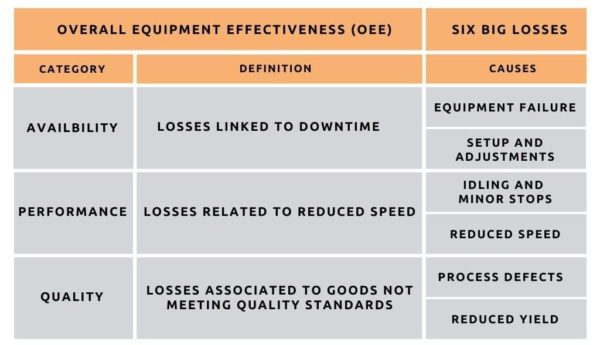With equipment failures costing manufacturers circa £186,000 per hour1, one key solution to the mounting challenge is to evaluate and mitigate any weaknesses originating from critical production-line assets to reduce downtime and cost. Using the productivity framework of Overall Equipment Effectiveness (OEE), we highlight how weighing best practice can be implemented to improve availability, performance and quality loss to significantly enhance efficiencies along your up and downstream weighing processes.
Why use the OEE framework to identify inefficiencies?
According to OEE.com, Overall Equipment Effectiveness is the gold standard framework and metric for identifying losses, benchmarking progress, and improving the productivity of manufacturing equipment2. By identifying the percentage of effective production time, OEE allows you to measure equipment productivity and identify any areas for improvement. Consequently, preventing downtime and costly repairs, with an overall goal of eliminating all production losses over time. As such, OEE can be used to pinpoint weighing inefficiencies by systematically looking at the six most common causes of equipment downtime (the Six Big Losses) under the categories of availability, performance and quality3.

Figure 1: Overview of OEE framework and 6 big losses
The impact of availability, performance and quality losses
Each loss can have a significant impact on the productivity of weighing processes as demonstrated by the following scenarios:
Availability loss:
Equipment failures due to lack of maintenance can cause unplanned stops resulting in lengthy, costly downtime and lead to future planned stops for adjustments and repairs of weighing equipment4.
Performance loss:
An operator selecting and weighing the wrong ingredient, or incorrectly weighing collated products, can lead to minor stops. Such incidences are often underestimated due to their shortness in duration and difficulty in measurement. Slow cycles or reduced speed caused by issues such as inadequate equipment maintenance are also undervalued. Although the equipment hasn’t stopped, it’s running at less than its optimum efficiency5 further affecting overall weighing productivity.
Quality loss:
Commonly, products are rejected due to being over or underweight. This can be caused by reasons such as incorrect checkweigher settings and poorly functioning weighing equipment. Not only does quality loss contribute to product waste, but critically to lost time producing faulty outputs6.
Can weighing best practices improve OEE?
Without a doubt. By applying the following weighing best practices to mitigate availability, performance and quality losses, your Overall Equipment Effectiveness can improve considerably.
Optimise uptime to combat availability loss:
- Prioritise maintenance at critical points
Begin by identifying your essential weighing equipment and understanding the repercussions of faults occurring up and downstream. Is there a risk of quality out-of-spec products? By improving the condition of equipment and prioritising preventative maintenance such as calibrations and servicing at critical points, you can reduce the risk of downtime across the whole production process.
- Understand your throughput requirements
Overloading equipment beyond capacity can lead to shock, failure and affect your ability to meet customers’ expectations. Understanding your throughput requirements and seasonal shifts is an essential step to assessing the risk of availability loss.
To maximise uptime, consider undertaking a weighing review with the support of a weighing partner. This invaluable process will help you to assess the suitability of your existing solutions or potential upgrades to flex around changing demands, and ultimately improve overall productivity.
- Implement a contingency plan
Despite the best planning, unforeseen downtime can still occur. Where practical to do so, storage of spare parts on-site or by your weighing partner can help you fast-track repairs and get back to full operation with minimal disruption.
Speed up productivity to control performance loss:
- Consider streamlining and automating processes
Operational streamlining is key to optimising weighing speed and productivity with automated data capture and automatic fault detection being two of the most powerful outputs.
As well as enabling automatic transmission of weighing data, centralised data management software systems such as the Minebea Intec’s StatisticalProcessControl@Enterprise offers real-time monitoring of weighing equipment status across all product lines. Together with daily performance logs and error notifications, the smart software solution empowers fast operator response to weighing concerns. Thereby, preventing unplanned stops that hinder productivity.
- Validate weights at goods in
Confirming weights at Goods In ensures that the ordered volume of materials are received. This can help to prevent a shortfall of ingredients downstream, lengthy stoppages and the need to reorganise production schedules.
- Optimise the infeed
Ensure production is running at optimum speeds by adjusting the infeed. This involves making sure that the space and time between the goods being weighed are reduced resulting in more products being weighed faster. Additionally, be sure to consult with a weighing partner to confirm the conveyor belt, which feeds the product across the scale is level. This will enable a smooth transition onto the weight platform for stable readings.
Establish batch consistency to reduce quality loss:
- Optimise the performance of upstream systems
By prioritising the preventative maintenance of upstream equipment such as bench scales or floor platforms, you can guarantee a higher percentage of goods are within specification. Consequently, achieving reduced volumes of rejections, product waste, giveaway and a higher yield.
- Invest in a quality checkweigher
To avoid costly recalls, invest in a high-precision, inline checkweigher such as the Minebea Intec Checkweigher Flexus® or Minebea Intec Synus® Checkweigher if functionality is not yet in place. These dynamic machines provide live production data on areas such as line performance, percentage of rejected goods and total weight volumes and are one of the best solutions for monitoring batch consistency.
Prioritise Overall Equipment Effectiveness with the best-fit weighing solutions
Understanding the criticality of OEE and focusing efforts to optimise the metric are essential undertakings for maximising weighing equipment productivity. However, without the knowledge and support, it can feel like a challenging and confounding task.
By following our OEE guidance, you can gain a solid foundation on how to assess your existing weighing processes against the framework and implement weighing best practices to enhance weighing productivity.
When you’re ready to further optimise OEE, be sure to collaborate with a weighing partner to help you define immediate and longer-term weighing solutions that are the best fit for your operations. Solutions may cover:
- Implementing bespoke preventative maintenance plans that can enhance weighing uptime and reduce cost.
- Via weighing reviews, identifying the best-fit soft and hardware solutions to improve productivity overall. Depending on your requirements and budget, recommended solutions may include the Minebea Intec Flexus® and Minebea Intec Synus® Checkweigher or introducing reporting software such as Minebea Intec’s StatisticalProcessControl@Enterprise.
Additional help is always at hand. For complimentary, engineer-led advice on how to enhance weighing productivity for improved OEE, contact our weighing experts for further guidance.
Sources
1 Manager Plus (2020) ‘The True Cost of Equipment Failure Will Shock You’ [Online] Available at https://managerplus.iofficecorp.com/blog/equipment-failure-cost Accessed 28th July 2021
2 OEE.com ‘What is overall equipment effectiveness?’ [Online] Available at https://www.oee.com/ Accessed 15th July 2021, paragraph 1
3 OEE.com ‘What is overall equipment effectiveness?’ [Online] Available at https://www.oee.com/oee-six-big-losses.html#overview Accessed 15th July, paragraph 1
4Trubaciute, V (2020) ‘The Six Big Losses in Manufacturing’ [Online] Available at https://evocon.com/kb/the-six-big-losses-in-manufacturing/ Accessed 15th July 2021, Overview chapter points 1 and 2.
5Trubaciute, V (2020) ‘The Six Big Losses in Manufacturing’ [Online] Available at https://evocon.com/kb/the-six-big-losses-in-manufacturing/ Accessed 15th July 2021, Overview chapter points 3 and 4.
6Trubaciute, V (2020) ‘The Six Big Losses in Manufacturing’ [Online] Available at https://evocon.com/kb/the-six-big-losses-in-manufacturing/ Accessed 15th July 2021, Overview chapter points 5 and 6.





